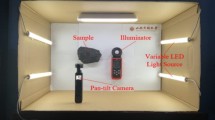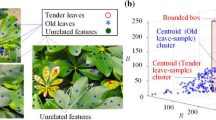Abstract
Chinese mitten crab is one of China's unique aquaculture species, which has significant economic value to the aquatic product market. In order to recognize different individual Chinese mitten crab, this paper proposes a method of first detection and recognition of carapace combined with YOLOv5 (You Only Look Once v5) and principal component analysis (PCA) and its improved method. First, the image of the Chinese mitten crab is obtained through the camera. Secondly, YOLOv5 and transfer learning method are used to detect the target of the Chinese mitten crab, and then the target is automatic cropped according to the detected target frame of Chinese mitten crab carapace. Finally, four methods of KPCA, one-dimensional PCA (1D-PCA), two-dimensional PCA (2D-PCA), and two-way two-dimensional PCA ((2D)2-PCA) were used for matching. The results show that the (2D)2-PCA recognition rate can reach 84.42%, which is 18.27%, 9.128% and 8.689% higher than the other three methods respectively. In addition, the matching speed only takes 1.859 s, compared with the other three methods. The method improves by 86.051 s, 2.562 s and 0.784 s, respectively. Therefore, this method has a better experimental effect in the experiment, and the recognition speed is faster. The results of the study can avoid the economic loss of aquatic products and provide a new research method for the recognition of the Chinese mitten crab carapace.










Similar content being viewed by others
Data availability
The datasets generated during and analysed during the current study are available from the corresponding author on reasonable request.
References
Cao L (2021) Study on pollution characteristics of typical crab pond culture growth cycle in Xinghua City. Dissertation, Yangzhou University
Cao LJ, Chua KS, Chong WK et al (2003) A comparison of PCA, KPCA and ICA for dimensionality reduction in support vector machine. Neurocomputing 55(1):321–336
Cao S, Zhao D, Sun Y et al (2021) (2021) Automatic coarse-to-fine joint detection and segmentation of underwater non-structural live crabs for precise feeding. Comput Electron Agric 180:105905. https://doi.org/10.1016/j.compag.2020.105905
Chen H, Cheng MQ, Dong Z et al (2021) Identification Methods and Research Progress on Eriocheir sinensis from Different Habitats. J Food Sci Biotechnol 40(03):11–17
Cui Y, Pan T, Chen S et al (2020) A gender classification method for Chinese mitten crab using deep convolutional neural network. Multimed Tools Appl 79(11):7669–7684
Deng YF, Xu ZC, Zhou J et al (2022) Construction and Directional Culture of the White-shell Families for Chinese mitten crab (Eriocheir sinensis). J Aquacult 43(05):15–17
Dong XQ, Chen HC, Xie SL et al (2014) Face recognition based on two-directional 2DPCA and genetic algorithm. J Cent China Norm Univ Nat Sci 48(05):656–661
Duan QL, Chen X, Xu GH et al (2022) Chinese Mitten Crab Weight Estimation Method Based on Multi-dimensional Features and LightGBM. Trans Chin Soc Agric Mach 53(08):353–360
Duan Y, Li DL, Li ZB et al (2015) Review on visual characteristic measurement research of aquatic animals based on computer vision. Trans Chin Soc Agric Eng 31(15):1–11
Feng YQ, Yang XT, Xu DM et al (2022) Recognition method of individual images of river crabs based on transfer learning and pyramid convolutional network. Fish Modernization 49(01):52–60
Goutte C, Gaussier E (2005) A probabilistic interpretation of precision, recall and F-score, with implication for evaluation. European conference on information retrieval 345–359
Hu ZG, Liu L (2013) Summer management of crab farming. Rural New Technol 06:21
Huff DT, Weisman AJ, Jeraj R (2021) Interpretation and visualization techniques for deep learning models in medical imaging. Phys Med Biol 66(04):04TR01
Idaszkin YL, Marquez F, Nocera AC (2013) Habitat-specific shape variation in the carapace of the crab C yrtograpsus angulatus. J Zool 290(2):117–126
Jiang XD, Cheng YX, Pan JL et al (2020) Landmark-based morphometric comparison analysis on carapace of wild Eriocheir sinensis collected from the Yangtze River and the Netherlands. Freshwater Fish 50(01):38–43
Johnston D, Lourey M, Van TD et al (2002) Water quality and plankton densities in mixed shrimp-mangrove forestry farming systems in Vietnam. Aquacult Res 33(10):785–798
Lalramchhani C, Paran BC, Shyne A et al (2020) Integrated rearing system approach in the farming of mud crab, shrimp, fish, oyster and periphyton in bracksihwater pond. Aquacult Res 51(10):4165–4172
Li H (2019) Research on anti-counterfeiting algorithm of Chinese mitten crab based on local image features. Anhui Univ. Technol 10–15
Li X, Dong BP, Yang MS et al (2019) Salmon Freshness Detection System Based on SVM Kernel Machine Learning. Trans Chin Soc Agric Eng 50(05):376–384
Li CY, Liu GD, Tan B (2022) Comparative Study on Hyperspectral Remote Sensing Data Dimensionality Reduction Based on PCA and KPCA. Geospatial Inf 20(07):89–93
Liu S, Qi L, Qin H et al (2018) Path aggregation network for instance segmentation. Proceedings of the IEEE conference on computer vision and pattern recognition 8759–8768
Liu Y, Zhang SM, Wang SX et al (2022) Research on optimization of aquarium fish target detection network. Fish Modernization 49(03):89–98
Luo RZ, Ran RS (2009) Face Recognition Based on Second-Order(2D)2PCA. Comput Appl Softw 26(11):223–226
Neubeck A, Van GL (2006) Efficient non-maximum suppression. 18th International Conference on Pattern Recognition 06:850–855
Pan X (1989) How to raise river crabs. Mod Agric 1989(06):32–33
Sun LQ, Liu T, Chen SH et al (2019) Research on multi-target fish object proposal detection algorithm. Trans Chin Soc Agric Mach 50(12):260–267
Sun YW, Zhang SM, Jiang KJ et al (2022) Research progress of application status of electronic monitoring technology in ocean fishing vessels and prospects. Mar Fish 44(01):103–111
Tai WP, Li H, Zhang BL et al (2021) Recognition of back shell features of Chinese mitten crab and its algorithm research. Period Ocean Univ China 51(01):138–146
Tang WM, Fei XD (2022) Aristocrats in the water: crabs in Hongze Lake. Jiangsu Rural Economy 05:68
Wang CJ, Lin Y (2019) Face Recognition Algorithm Based on 2D-PCA and 2D-MMC. Comput Knowl Technol 15(22):195–196
Wang H, Bao YQ, Xi J et al (2013) 2D SVD-FIR filter design based on 1D PCA-EIR technique. J Southeast Univ Nat Sci Ed 43(02):247–251
Wang JA, Chen KJ, Liu XY et al (2017) Research of growth characteristics of crabs in Datong Lake. J Hunan Univ Arts Sci (Sci Technol) 29(01):35–39
Wang SX, Zhang SM, Zhu WB et al (2021) Application of an electronic monitoring system for video target detection in tuna longline fishing based on YOLOV5 deep learning model. J Dalian Ocean Univ 36(05):842–850
Wang SX, Zhang SM, Liu Y et al (2022) Recognition on the working status of Acetes chinensis quota fishing vessels based on a 3D convolutional neural network. Fish Res 248:106226
Wang YD, Lu WD, Hu C et al (2022) Research on face image recognition based on PCA, LDA and LR fusion algorithm. Sci Technol Innov 22:72–75
Xue LQ, Shen HC, Zhang M et al (2022) Spatial and temporal distribution characteristics of water exchange capacity in Hongze Lake. Water Resour Prot 38(04):13–20
Yang J, Zhang D, Frangi AF et al (2004) Two-dimensional PCA: a new approach to appearance-based face representation and recognition. IEEE Trans Pattern Anal Mach Intell 26(1):131–137
Yang DH, Zhang SM, Tang XF (2019) Research and development of fish species identification based on machine vision technology. Fish Inf Strateg 34(02):112–120
Ye G, Xue M, Jia WY et al (2022) Feature extraction of face data with PCA mirror symmetry. Comput Knowl Technol 18(04):100–102
Yin L, Jiang XD, Wang HN et al (2022) Comparison of ecological breeding effects of Chinese mitten crab (Eriocheir sinensis) from different strains. Fish Sci Technol Inf 49(04):193–199
Yu H, Bennamoun M (2006) 1d-pca, 2d-pca to nd-pca.18th International Conference on Pattern Recognition (ICPR'06). IEEE 4:181–184
Zhang D, Zhou ZH (2005) (2D)2PCA: Two-directional two-dimensional PCA for efficient face representation and recognition. Neurocomputing 69(1–3):224–231
Zhang BL, Lian D, Ren HL (2014) Research on anti-counterfeiting system of Chinese mitten crab based on crab shell image. Sci Fish Farming 02:77–78
Zhang SM, Zhang H, Tang FH et al (2017) Research progress on fish swimming behavior monitoring by computer vision technology. J Dalian Ocean Univ 32(04):493–500
Zhang J, Zhang S, Fan W et al (2022) Research on target detection of engraulis japonicus purse seine based on improved model of YOLOv5. Front Mar Sci 9:1400
Zhang JZ, Zhang SM, Wang SX et al (2022) Recognition of Acetes chinensis fishing vessel based on 3–2D integration model behavior. South China Fish Sci 18(4):1–10
Zhao YF (2018) Palmprint Recognition Algorithm Based on 2D–2DPCA and Wavelet Transform. Digital World 2018(07):148
Zhao LH, Zhang XL, Xu XH (2007) Face recognition base on KPCA with polynomial kernels. 2007 International Conference on Wavelet Analysis and Pattern Recognition. IEEE 3:1213–1216
Zheng C, Jiang T, Luo R et al (2021) Geometric morphometric analysis of the Chinese mitten crab Eriocheir sinensis: A potential approach for geographical origin authentication. North Am J Fish Manag 41(4):891–903
Zhu P, Zhang Y, Chou Y et al (2019) Recognition of the storage life of mitten crab by a machine olfactory system with deep learning. J Food Process Eng 42(7):95–96
Acknowledgements
Chinese mitten crab samples in this article were provided by Sihong Youziwei Ecological Agricultural Products Co., Ltd. The photos of the crab pond breeding of Hongze Lake crabs are provided by Manager Tianyu Ling. Wang Wei, Laboratory of Genetics, Breeding and Biotechnology, East China Sea Fisheries Research Institute, Chinese Academy of Fishery Sciences, and Jianbo Dong, Jiangsu Fishery Law Enforcement and Supervision Center, gave guidance to the biological content of hairy crabs in the article.
Funding
This work was supported by National Natural Science Foundation of China under Grant No. 61936014, Laoshan Laboratory under Grant No.LSKJ202201804, Chinese Academy of Fishery Sciences basic scientific research fees under Grant No. 2020TD82.
Author information
Authors and Affiliations
Corresponding author
Ethics declarations
Conflict of interest
All authors declare that they have no conflict of interest.
Additional information
Publisher's note
Springer Nature remains neutral with regard to jurisdictional claims in published maps and institutional affiliations.
Supplementary Information
Below is the link to the electronic supplementary material.
Supplementary file1 (MP4 8532 KB)
Supplementary file2 (MP4 5127 KB)
Rights and permissions
Springer Nature or its licensor (e.g. a society or other partner) holds exclusive rights to this article under a publishing agreement with the author(s) or other rightsholder(s); author self-archiving of the accepted manuscript version of this article is solely governed by the terms of such publishing agreement and applicable law.
About this article
Cite this article
Zhang, J., Wang, S., Zhang, S. et al. Research on target detection and recognition algorithm of Eriocheir sinensis carapace. Multimed Tools Appl 82, 42527–42543 (2023). https://doi.org/10.1007/s11042-023-15228-w
Received:
Revised:
Accepted:
Published:
Issue Date:
DOI: https://doi.org/10.1007/s11042-023-15228-w




